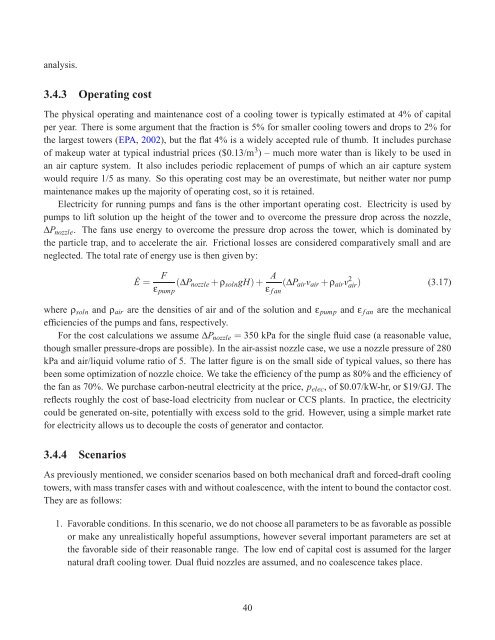Capturing CO2 from ambient air - David Keith
Capturing CO2 from ambient air - David Keith
Capturing CO2 from ambient air - David Keith
Create successful ePaper yourself
Turn your PDF publications into a flip-book with our unique Google optimized e-Paper software.
analysis.<br />
3.4.3 Operating cost<br />
The physical operating and maintenance cost of a cooling tower is typically estimated at 4% of capital<br />
per year. There is some argument that the fraction is 5% for smaller cooling towers and drops to 2% for<br />
the largest towers (EPA, 2002), but the flat 4% is a widely accepted rule of thumb. It includes purchase<br />
of makeup water at typical industrial prices ($0.13/m 3 ) – much more water than is likely to be used in<br />
an <strong>air</strong> capture system. It also includes periodic replacement of pumps of which an <strong>air</strong> capture system<br />
would require 1/5 as many. So this operating cost may be an overestimate, but neither water nor pump<br />
maintenance makes up the majority of operating cost, so it is retained.<br />
Electricity for running pumps and fans is the other important operating cost. Electricity is used by<br />
pumps to lift solution up the height of the tower and to overcome the pressure drop across the nozzle,<br />
ΔPnozzle. The fans use energy to overcome the pressure drop across the tower, which is dominated by<br />
the particle trap, and to accelerate the <strong>air</strong>. Frictional losses are considered comparatively small and are<br />
neglected. The total rate of energy use is then given by:<br />
˙E = F<br />
(ΔPnozzle + ρsolngH)+<br />
εpump<br />
A<br />
(ΔP<strong>air</strong>v<strong>air</strong> + ρ<strong>air</strong>v<br />
ε f an<br />
2 <strong>air</strong>) (3.17)<br />
where ρsoln and ρ<strong>air</strong> are the densities of <strong>air</strong> and of the solution and εpump and ε f an are the mechanical<br />
efficiencies of the pumps and fans, respectively.<br />
For the cost calculations we assume ΔPnozzle = 350 kPa for the single fluid case (a reasonable value,<br />
though smaller pressure-drops are possible). In the <strong>air</strong>-assist nozzle case, we use a nozzle pressure of 280<br />
kPa and <strong>air</strong>/liquid volume ratio of 5. The latter figure is on the small side of typical values, so there has<br />
been some optimization of nozzle choice. We take the efficiency of the pump as 80% and the efficiency of<br />
the fan as 70%. We purchase carbon-neutral electricity at the price, pelec, of $0.07/kW-hr, or $19/GJ. The<br />
reflects roughly the cost of base-load electricity <strong>from</strong> nuclear or CCS plants. In practice, the electricity<br />
could be generated on-site, potentially with excess sold to the grid. However, using a simple market rate<br />
for electricity allows us to decouple the costs of generator and contactor.<br />
3.4.4 Scenarios<br />
As previously mentioned, we consider scenarios based on both mechanical draft and forced-draft cooling<br />
towers, with mass transfer cases with and without coalescence, with the intent to bound the contactor cost.<br />
They are as follows:<br />
1. Favorable conditions. In this scenario, we do not choose all parameters to be as favorable as possible<br />
or make any unrealistically hopeful assumptions, however several important parameters are set at<br />
the favorable side of their reasonable range. The low end of capital cost is assumed for the larger<br />
natural draft cooling tower. Dual fluid nozzles are assumed, and no coalescence takes place.<br />
40








